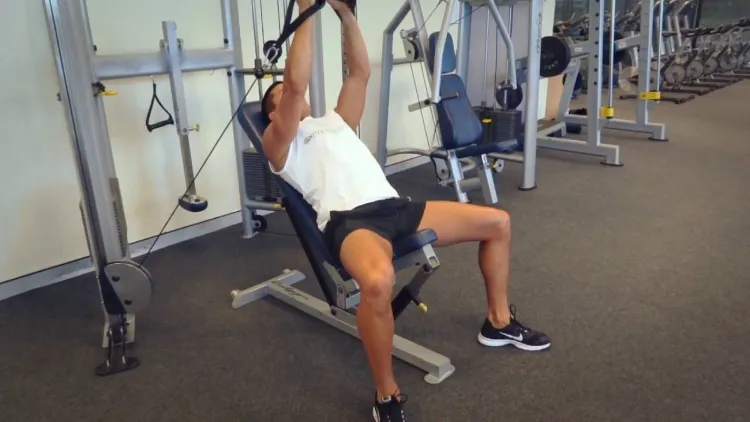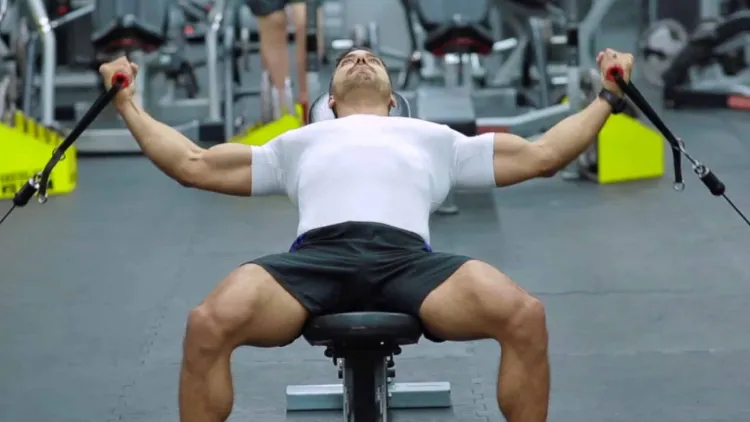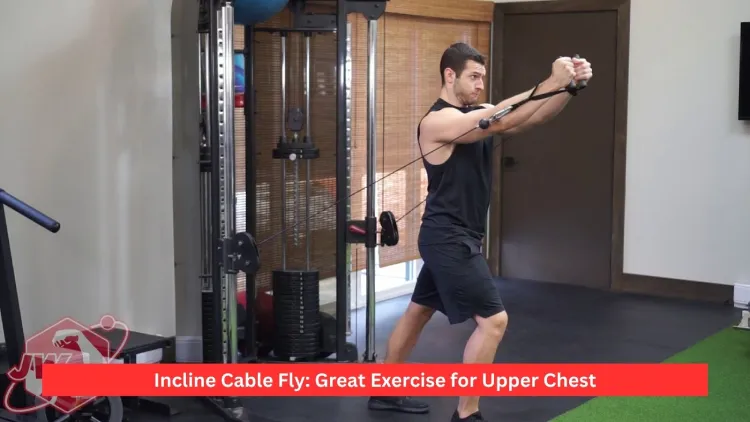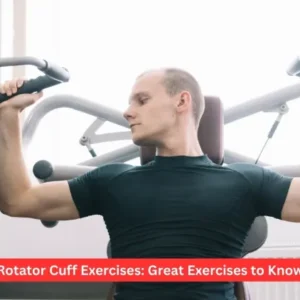The incline cable fly is considered to be one of the most effective exercises to build, shape and define the upper chest. It mainly affects the higher section of the pectoralis major and also involves the shoulders, arms, as well as the stabilising core muscles. This exercise is executed on a 30-45 degree incline bench so that tension is experienced during the entire movement, resulting in an increase in symmetry, increased muscle activity, and attractiveness. Adding incline cable fly in your chest exercise approach would produce stunning results, whether your goal is to increase growth, tighten, or simply enhance your posture.
- What Is an Incline Cable Fly?
- The Right Way to Do the Incline Cable Fly
- Muscles Engaged in the Incline Cable Fly.
- Advantages of Incline Cable Fly
- Common Mistakes to Avoid
- Variations of Incline Cable Fly
- How to Make Incline Cable Fly A Part of Your Workout.
- Tips for Maximum Results
- What Should You Do Incline Cable Fly?
- Safety Precautions
- Incline Cable Fly vs Other Chest Exercises
- Final Thoughts
- Frequently Asked Questions
What Is an Incline Cable Fly?
Incline cable fly is a resistance riding exercise that is done with the help of an adjustable bench and cable pulleys. The bench is tilted (usually 30 -45 degrees) to focus on the upper chest muscles – a part of the body that can be underexercised when compared to the middle and lower chest. With cables, there is constant tension, whereas with dumbbells, the sticks lose tension at the peak of the exercise.
This muscular tension can serve as a stimulus to the clavicular head of the pectoralis major, the triceps, and the front deltoids. The movement of the exercise resembles a broad hugging movement, which is really isolative of the muscles of the chest and involves limited participation of other muscles.

The Right Way to Do the Incline Cable Fly
When the incline cable fly is correctly performed, its engagement and safety are guaranteed. Follow these steps:
Setup:
Set the bench at a 30-45 degree inclination. Align the pulleys to a little less than your shoulder height or to the lowest height of your bench, as per the height of your bench. Attach D-handles to each side.
Starting Position:
Sit on a bench, take control of the handles, and recline, insisting on keeping your arms straight over your chest, and with a slight hindrance at the arms. Your hands must be resting on each other, and your shoulders on the bench.
Execution:
Position your arms in a wide arc, slowly, until you get a very strong stretch across the chest. Do not overstretch your shoulders to the risk of straining. To get the cables to the place of origin, you have to squeeze your chest muscles.
Breathing:
Breathe down upon your further lowering of the handles, and inhale upon your drawing up of them together.
The secret of a successful incline cable fly is control; the slower the motion, the better the tension and high-speed jerky movements may cause diminished action and injury.
Muscles Engaged in the Incline Cable Fly.
The major muscle that is engaged is the upper part of the pectoralis major, which is the part that gives the upper chest its lift and shape.
There are, however, a few secondary muscles involved:
- Anterior deltoids (front shoulders): Aid in the lifting of the arm.
- Biceps brachii: Stabilise when flying.
- Serratus anterior: Assists in shoulder movement.
- Core muscles: Keep the body stable at the incline bench.
The combination of the two makes the incline cable fly the best choice for making a rounded chest and defining the upper body.

Advantages of Incline Cable Fly
1. Targets the Upper Chest
Not many exercises can be considered to isolate the upper chest, as well as the incline cable fly. It is also very helpful among lifters who are keen on equalising their chest build or improving the look of the upper body.
2. Constant Tension
This is unlike dumbbells, as cables provide constant resistance during the movement, meaning that even the slightest movement will work towards muscle activation.
3. Supplier Chest Shape and Definition.
Using the emphasis on the area above the chest and the inner part of the pectorals, the exercise can be used to provide a more sculpted, lifted and symmetrical appearance.
4. Improves Posture
The posture of the upper chest is used to combat the forward shoulder, which most people with long hours have, and enhance the body’s posture.
5. Joint Safety
The cable system has a variable degree of movement that enables the relevant stress to be put on the shoulder joints during work, compared to heavy pressing exercises.
Common Mistakes to Avoid
The slightest mistakes may also make your incline cable fly less effectively.
The following are some of the most frequent mistakes and ways of correcting them:
- Excessive weight: The excessive weight may interfere with posture. Slow controlled reps are more important than overlifting.
- Overstretching: When you lower your arms excessively, they may cause strain on the shoulders. Halt when you experience moderate tension.
- Converting the fly into a press: Hold your elbows slightly bent about; with the straightening, your figure has transformed the action into a press.
- Wrong bench angle: Angles steeper than 45 degrees cause the focus to be taken on the shoulders instead of the chest.
- Hurrying movement: Momentum minimises muscle usage- gradual and constant movements are important.
These mistakes will be corrected and result in the most out of your upper chest usage, yet not harm you.

Variations of Incline Cable Fly
- Single-Arm Incline Cable Fly: To balance the two legs of the chest, working with one arm at a time greatly improves mind-muscle connection.
- Low to High Cable Fly: Adjust the pulleys to the low position and draw towards the upper chest. The version has the best upper pectoral stimulation and copies the chest lifting action of nature.
- High to Low Cable Fly: Going the opposite way (when using high ones down) works the lower chest and helps build chest.
- Incline Dumbbell Fly: In the absence of cables, dumbbells can be used; however, the resistance is less at the top of the lift.
- Incline Cable Press: This crossbreed of a fly and press gains power and muscle at the same time.
How to Make Incline Cable Fly A Part of Your Workout.
The incline cable fly may be easily incorporated into different chest exercises.
In the case of hypertrophy (muscle growth):
- 3–4 sets of 10–15 reps
- Firm, contraction and form-oriented moderate weight.
For toning or endurance:
- 3 sets of 15–20 reps
- Lightweight weight slower tempo.
Sample Chest Workout:
- Barbell Bench Press – 4×8
- Incline Dumbbell Press – 3×10
- Incline Cable Fly – 3×12–15
- Push-Ups – 3 sets to failure
This frame keeps all of your upper, middle and lower chest fibres stimulated in order to have balanced growth.
Tips for Maximum Results
- Angle: Hold your bench at an angle of 30-45. This is the best range to use in upper chest targeting.
- Control: Keep under consistent tension- no trembling.
- Squeeze at top: Squeeze your chest upwards, whether you can squeeze for 1-2 seconds and get the maximum work.
- Warm Up: Before heavy sets of arms and shoulders, always take a warm-up of light movements.
- Mind-muscle relation: Visualise the mind on the contraction of the chest as repeated.
A combination of consistency and technique will guarantee that results are visible in a few weeks.

What Should You Do Incline Cable Fly?
The incline cable fly suits every person who wants to construct or work out their upper chest.
Light weights can be used to learn control by beginning with lighter weights.
- It can be a final movement after the intermediate and advanced lifters are through with the movement to define the chest.
- Women will use it to enhance the wonderful firmness of the chest and posture without the enlargement of muscles.
- Experts and people involved in sports enjoy enhanced pushing strength and stability of the shoulders.
Safety Precautions
- Put on the check pulley attachments and handles.
- Be straight without humping over.
- Quit on the spot in case of acute pain in the shoulders.
- Not to be overstretched or bounced at the bottom.
- Both the lifting and lowering should be performed through controlled motion.
Incline Cable Fly vs Other Chest Exercises
It is a question for many lifters as to whether incline cable flies are more advantageous compared to the flat and decline movements. Although both are good, the incline version is the only version that focuses on the upper chest, which is usually overlooked in a pressing routine.
The incline fly applied less shoulder stress, and the resistance feels less bumpy than the crossovers, and in some cases of crossovers, it can result in overextension or imbalance. Pec deck machines are also not as safe and effective as cable fly when it comes to gaining natural strength and stability.
Compared to the fly, the chest press develops bulk and power, and the fly develops and isolates. Only with an ideal requirement of the two being in the whole workout.

Final Thoughts
The incline cable fly can also be considered one of the best and most diverse activities that can twist and tighten the upper chest. It prevents muscle imbalances, encourages muscle balancing and helps to support the movement under control, making it improve performance and appearance. You want to develop a larger chest, better posture, or definition, or you just want to ensure that your training outcomes are top-notch; the incline cable fly will allow you to do it.
The keys to success are a uniform routine, right form, and an intelligent choice of an angle (ideally, 30-45 degrees). Together with other forms of lifts involving the use of a cable, the incline cable fly can assist in shaping a strong, balanced, and built body in the upper part of the body.
Frequently Asked Questions
1. What are the muscles used in the incline cable fly?
It appeals to the upper chest, as well as to the front shoulders and arms.
2. Which angle to use on the incline cable fly is the best?
The perfect inclination of the chest to be active is between 30 and 45 degrees.
3. Is it a better idea to use incline cable flies and not use flat flies?
Yes, they give much attention to the upper chest, whereas flat flies are on the top, middle chest.
4. Are flies with an incline cable going to build muscle?
Yes, when they are controlled and formulated, they construct and shape the chest.







